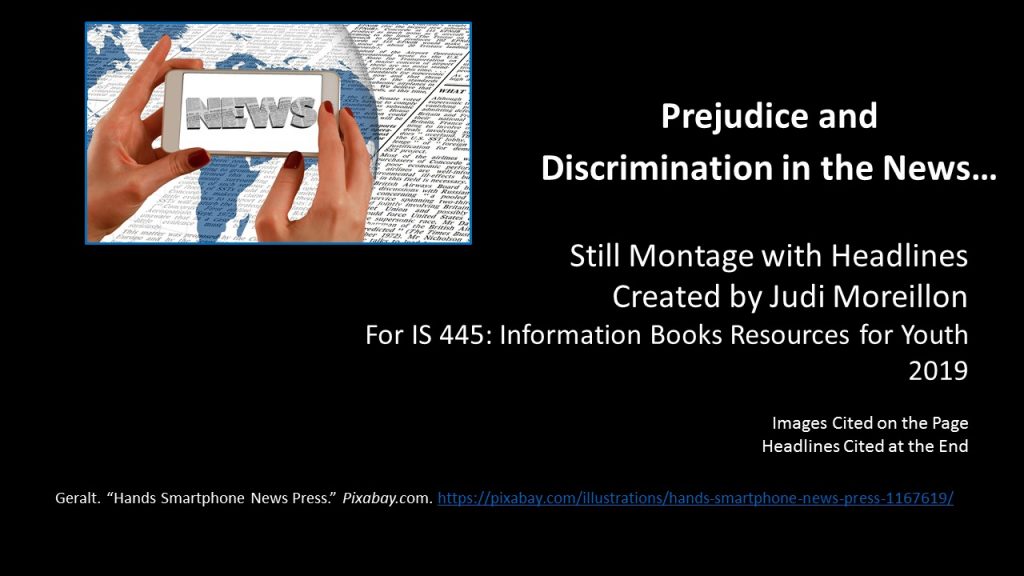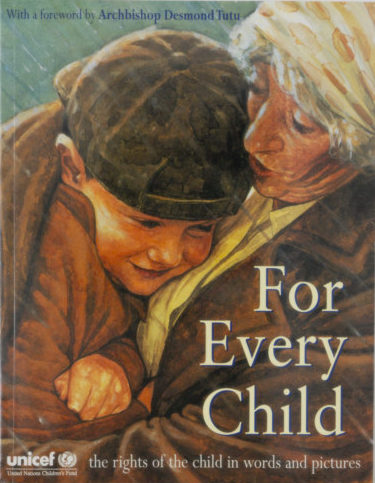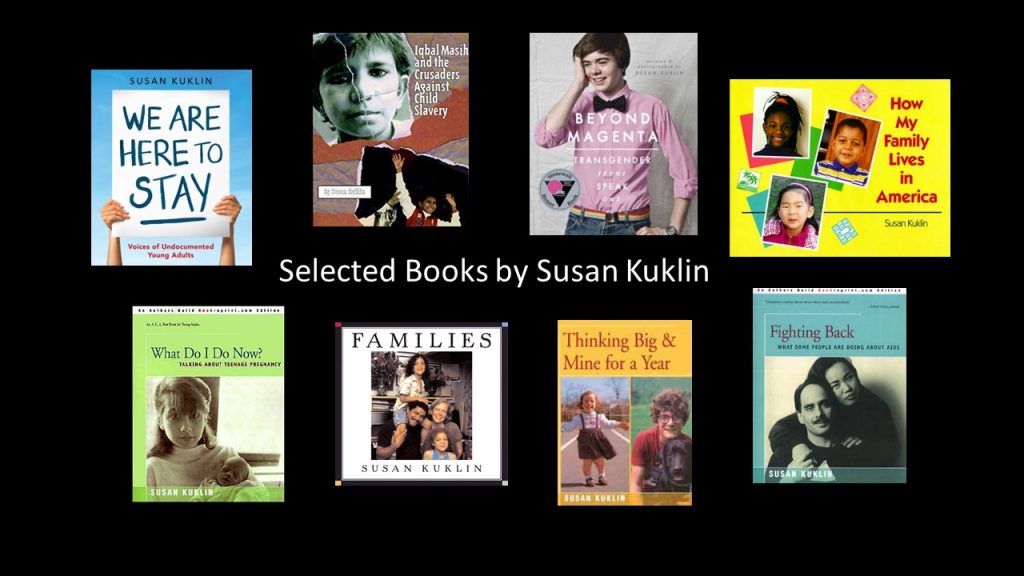Judi Moreillon, University of Illinois, Urbana-Champaign
Before beginning our whole-class Guided Inquiry Design (GID) experience, I shared information about the eight phases of the process. Students also read a chapter from my latest professional book that describes the process in detail. I shared my experience of using the GID with K-12 students and in professional development activities for educators and librarians. I explained the purpose for modeling the process and let students know they would engage in small group inquiry projects later in the course and could also select an inquiry process for a choice project assignment.
Open: Prejudice and Discrimination
The “Open” phase of the GID is designed to stimulate learners’ curiosity, pique their interest, and invite them to join in the inquiry process. Educators often launch this phase by posing a question, problem or dilemma. The Open phase may begin with a read aloud, a selection of media or a short text that hones in on the inquiry topic or theme. The overarching or essential question for the inquiry can also serve as a prompt for connecting learners to the topic and opening and engaging their minds.
I launched our inquiry into prejudice and discrimination by sharing a photo montage of global current events images and brief print from newspaper and website headlines focused on children and teens who currently experience prejudice and discrimination. My goal was to focus students’ thinking on how global prejudice and discrimination impact today’s youth.

Slideshare Link: https://www.slideshare.net/jmoreillon/prejudice-and-discrimination-in-the-news
I asked students to briefly record their responses–connections, thoughts and questions–to this presentation. Then I read aloud For Every Child: The UN Convention on the Rights of the Child in Words and Pictures by Caroline Castle, illustrated by various notable children’s picturebook illustrators. Again, I asked students to reflect privately in writing about this UN document and record questions they had and make connections to the photo montage.
 Before inviting students to post their initial thoughts, questions and comments in the chat feature of our online course, I cited information about the number of signers on the UN Convention and the fact that the United States has not signed. Students immediately began posting in the chat. Students responded to the images and news headlines, which were familiar to them. They shared sadness; some of their comments suggested sympathy for the plight of the young people depicted in the slideshow. The most frequently asked question was: “Why hasn’t the U.S. signed this document?” I noted that we would continue to explore these ideas through our overarching (essential) question for this inquiry:
Before inviting students to post their initial thoughts, questions and comments in the chat feature of our online course, I cited information about the number of signers on the UN Convention and the fact that the United States has not signed. Students immediately began posting in the chat. Students responded to the images and news headlines, which were familiar to them. They shared sadness; some of their comments suggested sympathy for the plight of the young people depicted in the slideshow. The most frequently asked question was: “Why hasn’t the U.S. signed this document?” I noted that we would continue to explore these ideas through our overarching (essential) question for this inquiry:
Is it important that students interact with global nonfiction and informational books and resources when they investigate prejudice and discrimination as it impacts the lives of young people today?
Immerse Phase: Author/Photographer Susan Kuklin Author Study
Last March at the Tucson Festival of Books, I was fortunate to attend a panel presentation on writing nonfiction books for young people. Author-photographer Susan Kuklin was on the panel and shared information about her book We Are Here to Stay: Voices of Undocumented Young Adults. I was especially moved by Kuklin’s relationships with the teens she interviewed for the book. She noted that these young people originally wanted to use their real names and photographs in the book. However, after the new administration was inaugurated, it become clear that this plan could have tragic consequences. Instead, these first-person narratives of the lives of undocumented U.S. teens were published with pseudonyms and blank picture frames where their portraits would have been. I connected with Kuklin via Twitter during and after the TFOB and invited her to be a guest speaker in our course. She readily agreed.

As a result, the Immerse phase of our inquiry involved graduate students in reading information about Kuklin’s work and reading one or more of her books. Students were asked to read information on Kuklin’s website and read the interview conducted by Lacey Nehls for the Worlds of Words’ blog feature Author’s Corner in January 2019. Students read one or more of the following books (the starred books were recommended for the inquiry).
• After a Suicide: Young People Speak Up (Putnam, 1994)
• All Aboard! A True Train Story (Orchard, 2003)
• * Beyond Magenta: Transgender Teens Speak Out (Candlewick, 2014)
• * Families (Hyperion, 2006)
• * Fighting Back: What Some People Are Doing about AIDS (Putnam, 1989)
• * Hoops with Swoopes (Hyperion, 2001)
• * How My Family Lives in America (Simon & Schuster, 1992)
• * Iqbal Masih and the Crusaders Against Child Slavery (Holt, 1998)
• No Choirboy: Murder, Violence, and Teenagers on Death Row (Holt 2008)
• Reaching for Dreams: A Ballet from Rehearsal to Opening Night (Lothrop, Lee & Shepard 1987)
• * Thinking Big/Mine for a Year (Putnam, 1984)
• Trial: The Inside Story (Holt, 2001)
• * We Are Here to Stay: Voices of Undocumented Young Adults (Candlewick, 2019)
• * What Do I Do Now? Talking about Teenage Pregnancy (Putnam ,1991)
In addition, I provided a virtual book talk/podcast for Iqbal Masih and the Crusaders Against Child Slavery by Kuklin. In the talk, I connect child labor to prejudice and discrimination toward children who are denied their right to an education, play and quality time with their families and peers.
Immerse Phase: Author Visit
Using our course hashtag (#is445) and Kuklin’s Twitter handle, students tweeted the titles of the books they were reading and their initial responses before the author visit. Some tweeted their questions, too, which was helpful to Kuklin who began following our course on Twitter. Students brought their prepared questions to the author visit and modified their questions based on their classmates’ questions and Kuklin’s responses. The conversation was lively and lasted a full hour. Kuklin remarked on the depth of the students’ questions. (She also noted satisfaction with the online format.)
Interacting with Kuklin put the spotlight on narrative nonfiction books, underrepresented youth and children and teens who have experienced prejudice and discrimination. The majority of Kuklin’s books are multicultural and based on interviews and research. We Are Here to Stay and her forthcoming book involving interviews with refugees present global perspectives. Ms. Kuklin, who considers herself a teller of other people’s stories rather than an activist, does not shy away from controversial issues. Our conversation with her furthered students’ thinking about young people who have experienced prejudice and discrimination and about books and resources that authentically tell their stories. Students tweeted their take-aways after the visit as well.
Before the visit, students introduced themselves and responded to each other’s introductions using FlipGrid.com. With a bit of information about one another, a shared background of reading Kuklin’s books and the author visit as a context, I engaged students in an intersectionality activity. I began by sharing my own identities, followed by a discussion of our many identities. Then I randomly assigned students to partners. Together, they mapped their individual and intersecting identities on Venn diagrams. When we came back together as a class, students used the chat to share their similarities, differences and surprises. This engagement was intended to prepare them to interact with the nonfiction and information books and resources on the Explore pathfinder, the focus of the next phase of the GID.
Journey through Worlds of Words during our open reading hours: Monday-Friday, 9 a.m. to 5 p.m. and Saturday, 9 a.m. to 1 p.m. To view our complete offerings of WOW Currents, please visit archival stream.
